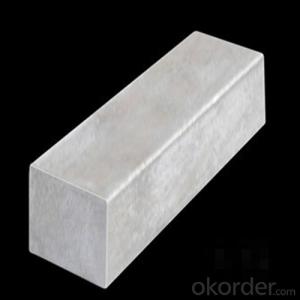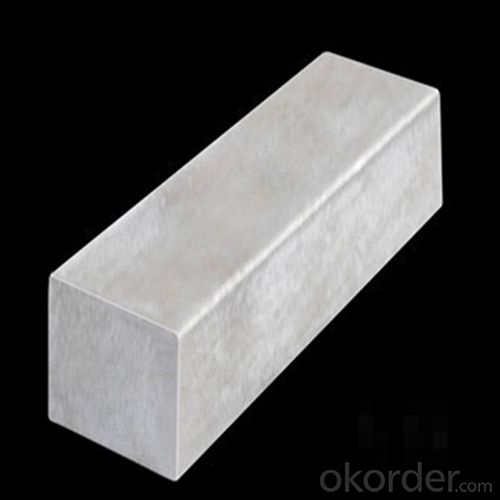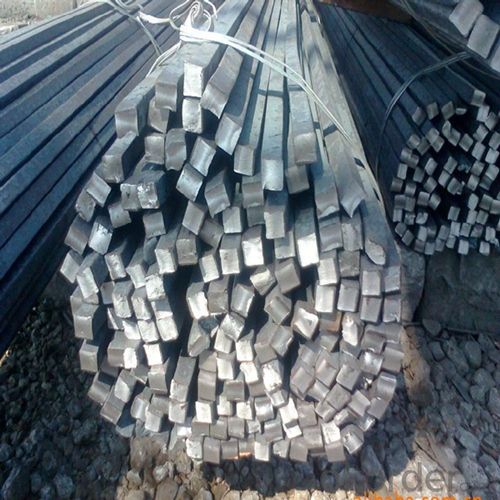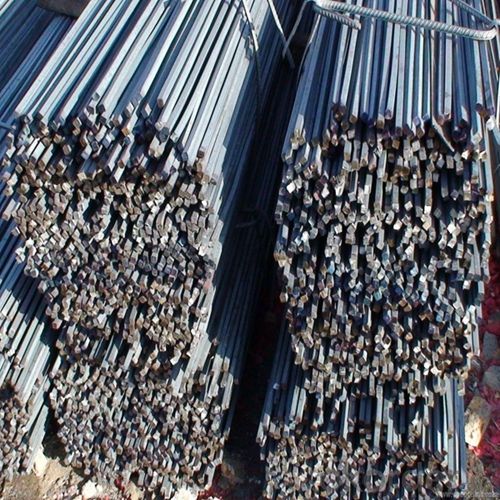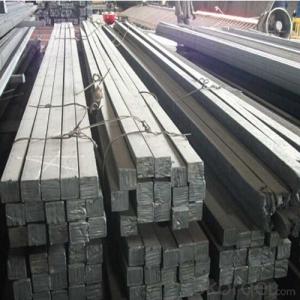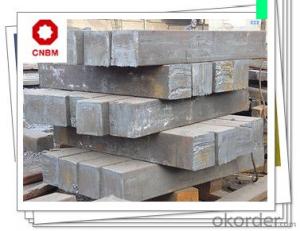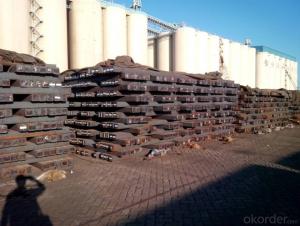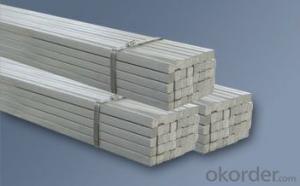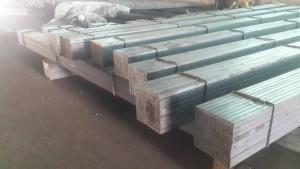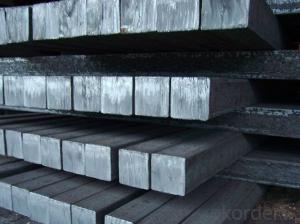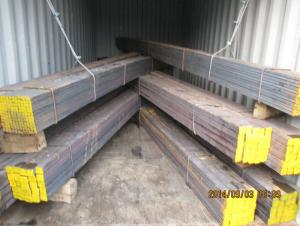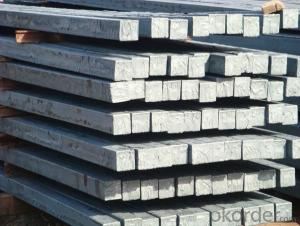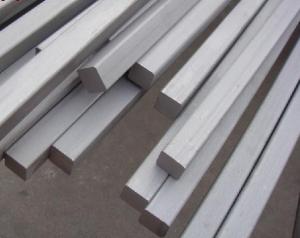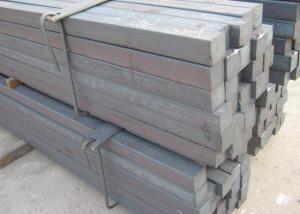Carbon Steel Square Bar for Ship Parts Chinese Standard Q235
- Loading Port:
- Tianjin
- Payment Terms:
- TT or LC
- Min Order Qty:
- 25 m.t.
- Supply Capability:
- 10000 m.t./month
OKorder Service Pledge
OKorder Financial Service
You Might Also Like
1. Structure of Carbon Steel Square Bar description
Carbon steel square bar is a bar with square shaped cross-section. It is special case of equal sides. Before steel products are sold on the market, the steel must first be processed into more functional pieces. Raw steel cannot be of use while in its pure form, thus it has to be cast into shape. The freshly made steel, carbon steel square bar is still in the form of a metal bar or rectangle. Small sizes of carbon steel square bar is used in ship building.
2. Main Features of Carbon Steel Square Bar
• Grade: Q235
• Type: Mild carbon steel
• A quadrilateral with four equal sides and four right angles.
• Vibration: The stiffness and mass are chosen to prevent unacceptable vibrations, particularly in settings sensitive to vibrations, such as offices and libraries.
• Local yield: Caused by concentrated loads, such as at the beam's point of support.
3. Carbon Steel Square Bar Images
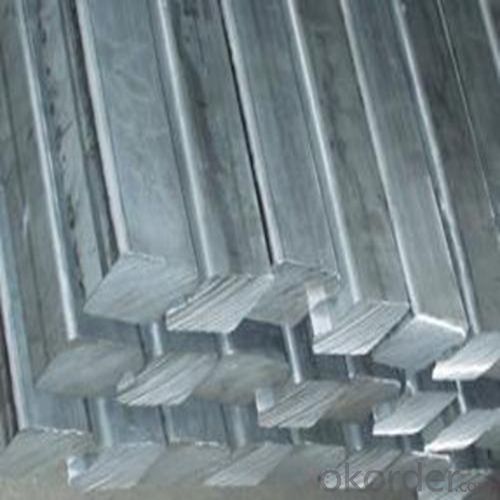
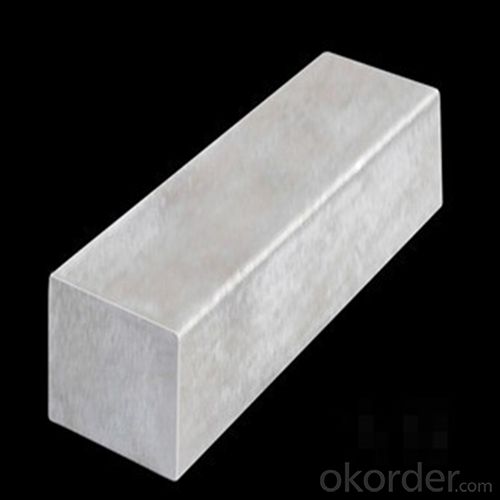
4. Carbon Steel Square Bar Specification
Mechanical Properties | Grade | Steel diameter(mm) | |||
≤16 | 16~40 | 40~60 | 60~100 | ||
Yield Point Δs/MPa | Q195 | ≥195 | ≥185 | - | - |
Q235 | 235 | 225 | 215 | 205 | |
Tensile Strength | Q195 | 315~390 | |||
Q235 | 375~500 | ||||
Elongation δ5% | Q195 | ≥33 | ≥32 | - | - |
Q235 | 26 | 25 | 24 | 23 | |
5. FAQ
We have organized several common questions for our clients,may help you sincerely:
①What is the main material?
There are two types of Square Bar, one is hot rolled square bar and other one is cold drawn square bar. Our principal products is hot rolled square bar. We dedicate to products with material Q195 and Q235. We offer products with high quality and low price.
②How to inspect the quality?
We have a professional inspection group which belongs to our company. We resolutely put an end to unqualified products flowing into the market. At the same time, we will provide necessary follow-up service assurance.
③Is there any advantage about this kind of product?
Steel I beam bar IPE has a reduced capacity in the transverse direction, and is also inefficient in carrying torsion, for which hollow structural sections are often preferred.
- Q: How accurate are steel squares?
- Steel squares are generally considered to be highly accurate measuring tools. Their accuracy depends on the quality of the manufacturing and the precision of the markings on the square itself. High-quality steel squares have precise angles and straight edges, allowing for accurate measurements and squareness checks. However, it is important to note that even the best steel squares may have slight variations due to manufacturing tolerances. To ensure the accuracy of a steel square, it is recommended to check it against a known reference or a precision measuring instrument. This can be done by placing the square against a flat surface and verifying that the edges are parallel and the angles are square. If any discrepancies are found, adjustments can be made or the square can be replaced if necessary. Overall, steel squares are generally reliable and accurate tools for measuring and checking squareness. However, it is always important to verify their accuracy and perform regular maintenance to ensure their continued precision.
- Q: Can a steel square be used for checking the squareness of a miter saw blade?
- Using a steel square is not suitable for verifying the squareness of a miter saw blade. Although a steel square is effective for measuring and assessing right angles, it lacks the specific design to accurately determine the squareness of a miter saw blade. Miter saws possess their own mechanisms and adjustments to guarantee the blade's perfect perpendicularity to the table. To verify the squareness of a miter saw blade, it is advisable to utilize a specialized tool known as a squareness gauge or a designated square explicitly created for miter saws. These tools are intended to deliver precise measurements and angle checks, guaranteeing precise and square cuts.
- Q: What are some common uses for a steel square in woodworking joinery?
- Some common uses for a steel square in woodworking joinery include checking for squareness and measuring angles, marking and transferring measurements, checking for flatness and straightness, and aligning and testing joints.
- Q: How do you use a steel square to mark a line perpendicular to a board edge?
- To use a steel square to mark a line perpendicular to a board edge, follow these steps: 1. Place the steel square against the board edge, ensuring that one leg (the shorter side) is flush against the edge, while the other leg (the longer side) extends outwards. 2. Hold the square firmly in place, making sure it doesn't shift or move during the marking process. 3. Take a pencil or a marking knife and slide it along the longer leg of the square, starting at the edge of the board. The longer leg of the square acts as a guide for a perfectly perpendicular line. 4. Continue marking the line along the length of the board, maintaining contact between the pencil or marking knife and the longer leg of the square. 5. Once you have marked the entire line, double-check to ensure that it is indeed perpendicular to the board edge. You can do this by using a measuring tape or another square to verify that the distance between the marked line and the board edge remains consistent along the entire length. By using a steel square in this manner, you can easily and accurately mark a line perpendicular to a board edge for various woodworking or construction projects.
- Q: How do you use a steel square to measure the height of a door opening?
- To measure the height of a door opening using a steel square, follow these steps: 1. Hold the steel square vertically against the side of the door opening, making sure that the door frame aligns with the long side of the square. 2. Ensure that the square is positioned in a way where one of its edges is in line with the floor or any other reference point you prefer as a starting point. 3. Slide the square upwards along the door frame until the other edge of the square reaches the top of the door opening. 4. Once the square is in place, examine the markings on its vertical edge. These markings indicate measurements in inches or centimeters. 5. Take note of the measurement where the top edge of the door opening aligns with the square. This measurement represents the height of the door opening. 6. Repeat the process on the opposite side of the door opening to ensure accuracy. If there are slight variations in the measurements, calculate the average for a more precise result. Using a steel square to measure the height of a door opening offers a straightforward and reliable method for obtaining accurate measurements for diverse purposes, such as installing a new door or ordering a customized one.
- Q: How do you use a steel square to draw perpendicular lines?
- Drawing perpendicular lines using a steel square requires following a few simple steps. Begin by placing the steel square on the drawing surface, ensuring that one edge rests against the starting point of the desired line. It is important to align the edge of the square with either the reference line or the edge of the paper. Then, firmly hold the square in place and position your pencil against one of the square's edges, making sure the pencil tip touches the paper. While keeping the square steady, carefully slide the pencil along the square's edge, drawing a straight line. This line will be perpendicular to the reference line or the edge of the paper, thanks to the right angle formed by the steel square. For drawing multiple perpendicular lines, repeat this process, starting with the square properly positioned and maintaining alignment as each line is drawn. Remember to double-check the square's alignment and make adjustments if necessary to ensure precise perpendicular lines. With practice, the effective use of a steel square for drawing perpendicular lines in your projects can be achieved.
- Q: What are some common techniques for using a steel square in furniture making?
- There are several common techniques for using a steel square in furniture making that can help ensure accurate and precise measurements. Here are some of them: 1. Checking for squareness: One of the primary uses of a steel square is to check for squareness in furniture pieces, such as tabletops or cabinet frames. By aligning the square's long edge against the edge of the piece, you can determine if it is perfectly perpendicular or if adjustments are needed. 2. Marking angles: Steel squares often come with angle markings, allowing you to accurately measure and mark angles for miters, bevels, or other angled cuts. This is especially useful when creating angled joints or decorative details in furniture pieces. 3. Transferring measurements: Steel squares have both inch and metric scales, making them useful for transferring measurements from one part of a furniture piece to another. By aligning the square's edge with a reference point, you can easily mark the corresponding measurement on another piece. 4. Checking for flatness: When working with large, flat surfaces like tabletops or panels, a steel square can be used to check for flatness. By placing the square diagonally across the surface, you can identify any gaps or unevenness that may need to be corrected. 5. Creating parallel lines: Steel squares can be utilized to create parallel lines for various purposes in furniture making. By aligning the square's edge with a reference line, you can easily mark multiple parallel lines at the desired distance. 6. Determining board thickness: Steel squares often have notches on the inside corner, allowing you to measure the thickness of a board or determine the depth of a mortise or groove. This can be helpful when fitting joinery or checking if a piece will fit into a specific space. Overall, a steel square is an essential tool in furniture making that allows for accurate measurements, checking for squareness, creating angles, and ensuring flatness. By mastering these techniques, furniture makers can achieve precision and quality in their craft.
- Q: What are the common applications of a steel square in metal fabrication?
- A steel square, also known as a framing square or a carpenter's square, is commonly used in metal fabrication for various applications. Some of the common uses include measuring and marking right angles, checking the squareness of corners and edges, laying out and marking cuts, and aligning and squaring components during fabrication. It is a versatile tool that helps ensure accuracy and precision in metalwork.
- Q: Can a steel square be used for checking the flatness of a floor?
- Yes, a steel square can be used for checking the flatness of a floor. A steel square is a versatile tool that can be used for various measuring tasks, including checking the flatness of surfaces. To use a steel square for this purpose, you would need to place it on different areas of the floor and observe if there are any gaps or unevenness. By sliding the square across the floor and checking for any inconsistencies, you can determine if the floor is flat or if there are any high or low spots. However, it is important to note that a steel square may not be the most precise tool for this task, as it cannot detect minor variations in the floor's flatness. For more accurate measurements, specialized tools such as a laser level or a straightedge may be required.
- Q: What are the different techniques for using a steel square in woodworking joinery?
- Woodworking joinery can be achieved with accuracy and precision using various techniques with a steel square. These techniques serve specific purposes and are commonly used in woodworking. Here are some examples: 1. Squareness check: To ensure perfect square corners in joints or workpieces, the steel square is indispensable. By placing the square against the workpiece's edge, you can verify if the adjoining edge is perpendicular to it. This technique is crucial for creating sturdy and stable joints. 2. 90-degree angle marking: When marking a 90-degree angle on a workpiece, the steel square is a useful tool. By aligning the square with the workpiece's edge and tracing along its inside edge using a pencil or marking knife, consistent and accurate marking can be achieved for precise joinery. 3. Marking non-90-degree angles: Steel squares often have additional markings that facilitate measuring and marking angles other than 90 degrees. By aligning the desired angle measurement with the workpiece's edge, you can accurately mark the angle required for complex joinery. 4. Plumb and level determination: Steel squares can be used to check if a workpiece is plumb (vertical) or level (horizontal). By holding the square against the workpiece's edge and using a spirit level or plumb bob, proper alignment of the project can be ensured. 5. Measurement transfer: Steel squares are also useful for transferring measurements from one workpiece to another. By aligning the square with the edge of the first workpiece and marking the desired measurement, you can then transfer that measurement to the second workpiece using the square as a guide. 6. Mitered corner creation: When working with mitered corners, the steel square is essential for achieving accurate angles. By placing the square against the workpiece and aligning it with the desired angle, precise marking and cutting of the joint can be accomplished, resulting in clean and tight mitered corners. In conclusion, the steel square is a versatile and valuable tool for woodworking joinery. Whether you need to check for squareness, mark angles, determine plumb and level, transfer measurements, or create mitered corners, the steel square provides the precision and accuracy required for successful woodworking projects.
Send your message to us
Carbon Steel Square Bar for Ship Parts Chinese Standard Q235
- Loading Port:
- Tianjin
- Payment Terms:
- TT or LC
- Min Order Qty:
- 25 m.t.
- Supply Capability:
- 10000 m.t./month
OKorder Service Pledge
OKorder Financial Service
Similar products
Hot products
Hot Searches
Related keywords
